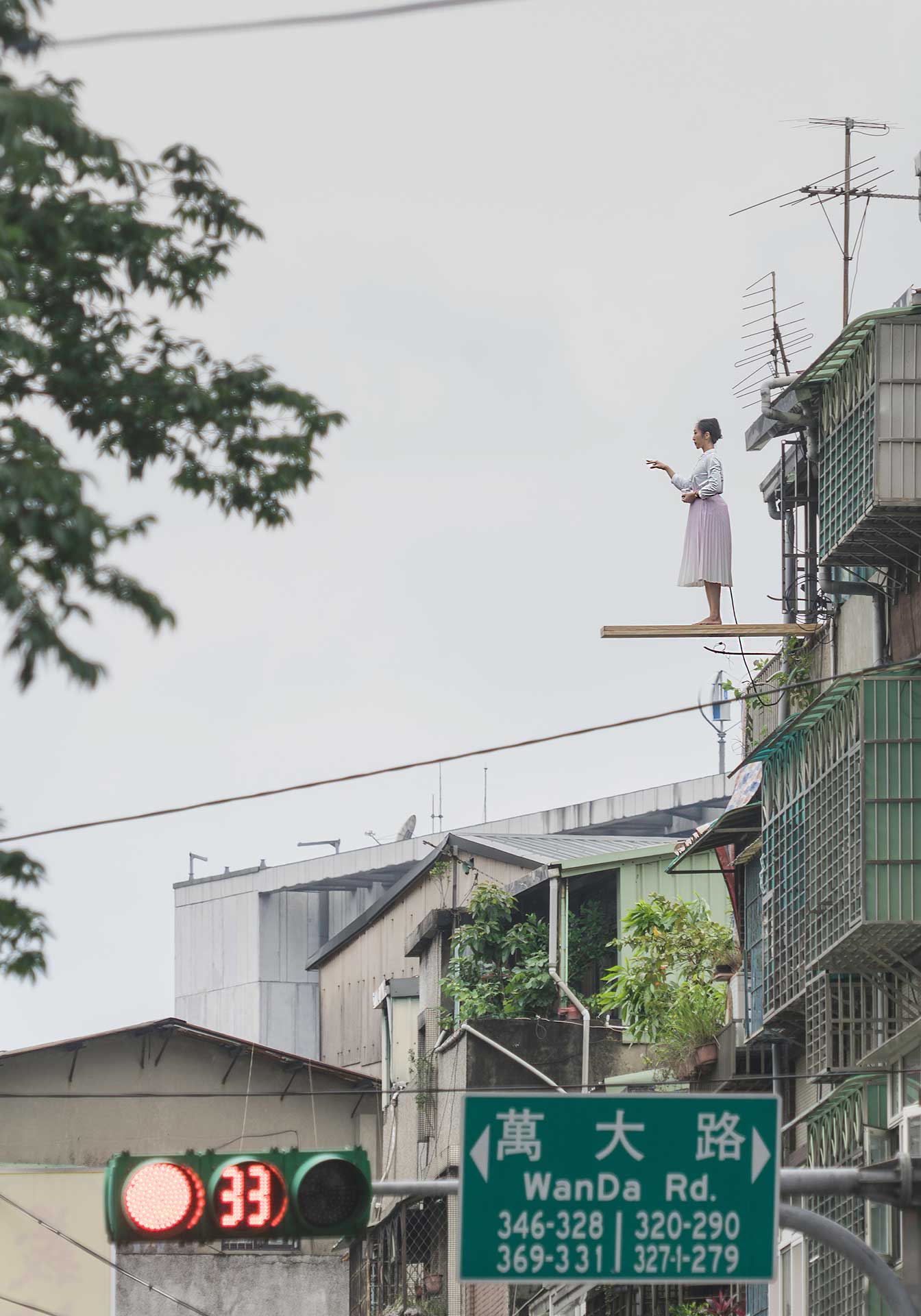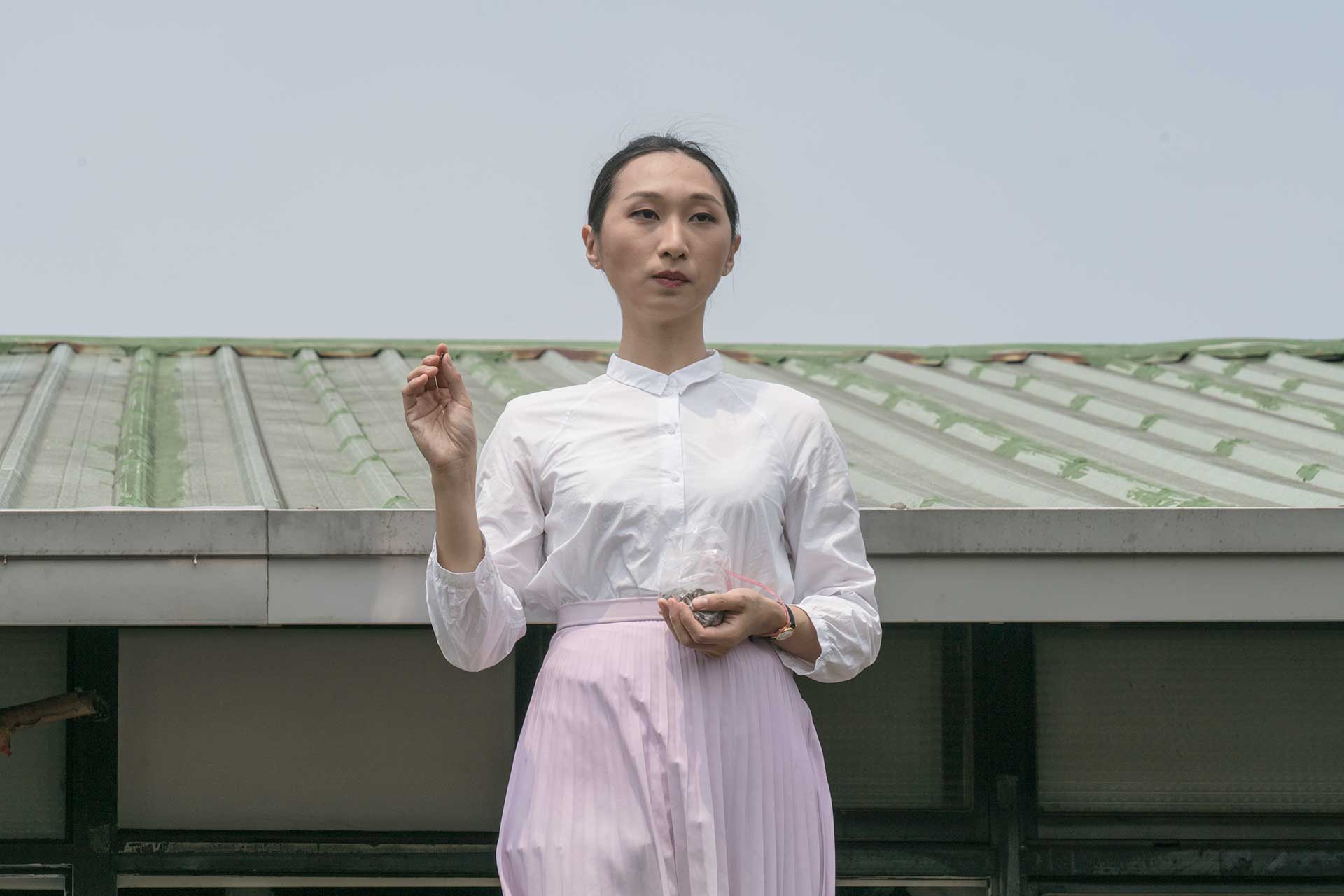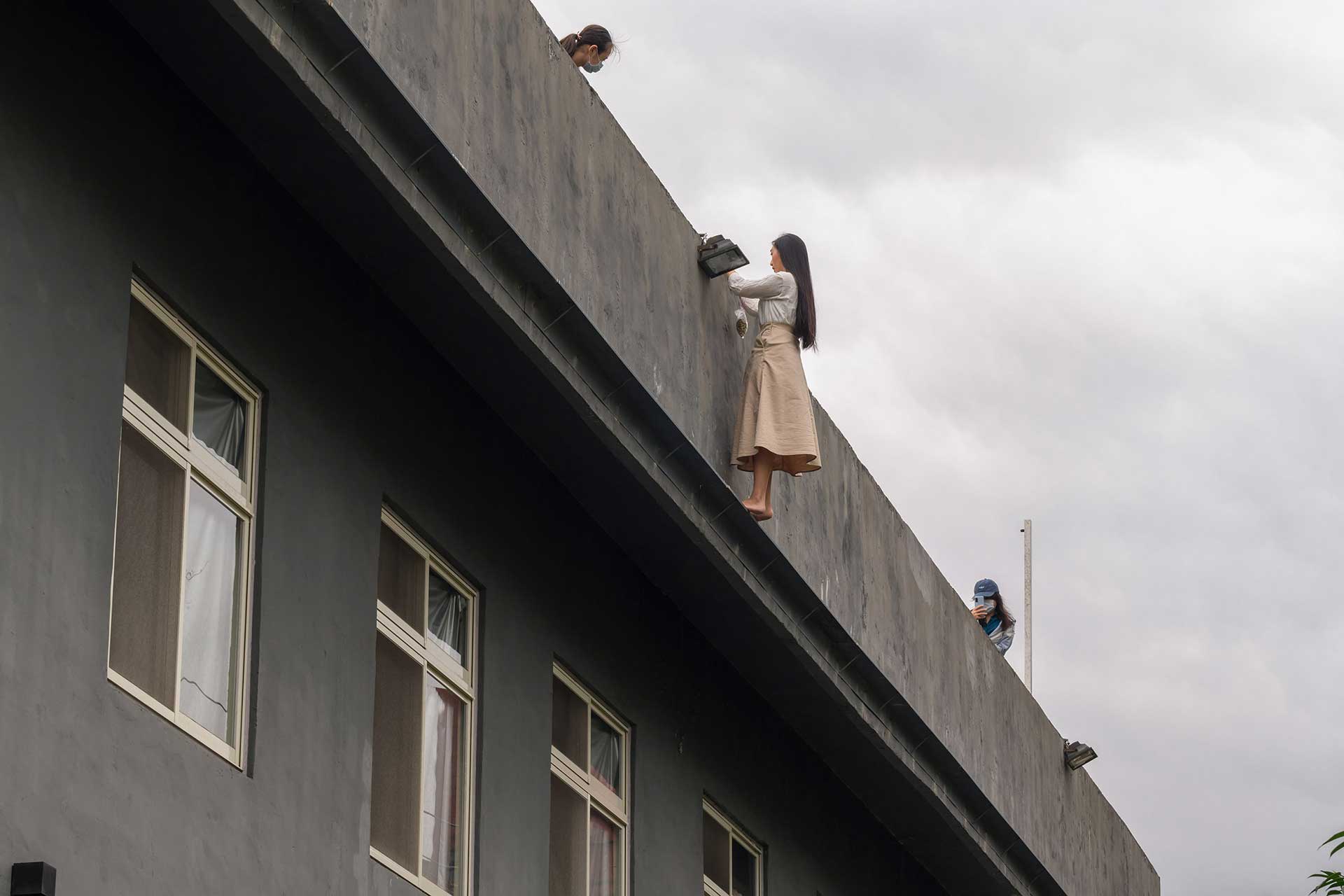It’s Us, Not You: Curatorial Notes on the 6th Asia Triennial Manchester
Over the last few years, the Taiwanese artist Hsu Yi Ting has performed a series of works titled Floating Body. In all of these she sits, perches, or stands on a temporary elevated structure, sometimes a kind of piratical plank overhanging a void. Sometimes she balances precariously on the external ledge of a high-rise building. Often, she simultaneously performs a casual act, like consuming roasted watermelon seeds, peanuts, or tangerines, then discarding the shells or peels below, littering the spaces she inhabits, and also perfuming them – corrupting their often institutionally clinical disconnect with everyday life. These apparently casual or habitual behaviours of consumption and the inherent production of waste central to them, are rendered strange when combined with highly risky balancing acts, as she side-steps barefooted on a concrete ledge, or holds her stillness for over an hour on a thin wooden board, perilously high above ground level over a busy central Taipei street.
In the artist’s words these acts explore individual crises “within capitalist structures,” highlighting vulnerabilities “caused by commodification, overload, anxiety, and surveillance.”1 They also explore power, hierarchies, and the different perspectives varied subject-positions produce. Yi Ting’s artistic acts consequently speak to a decolonial, eco-feminist, and quietly activist set of enquiries. They make for a stark contrast to similar gestures in art’s earlier mainstream Western histories, such as the neo-avant-garde, flamboyant ‘Giant Leap into the Void’ Yves Klein famously took in 1960, from the second-floor window of a Paris building. In opposition to Yi Ting’s long-durational embodied performances and the filmic and documented recordings she carefully choreographs of them, the iconic image of Klein’s leap (an artist who used female bodies as his own performative medium) was produced via montage and manipulation by photographers Harry Shunk and János Kender.2 Yi Ting’s practice self-consciously refers back to, but distances itself from, a long line of feminist and body-based long-durational works begun in the 1960s, which interrogated vulnerability and placed the female artist’s body in dangerous or transgressive positions. Unlike the sometimes sensationalist and theatrical bent of such figures as Marina Abramović, Yi Ting’s modest interventions play with a different kind of collective crisis. In her own words, often as a performer she “adopts a precarious posture to protest the powerlessness and frustration experienced in the competition for social resources, evoking distant empathy through the defamiliarizing context.”3

Yi Ting’s Floating Body series also gently signals sites of suicidal acts. Jumping from high-rise buildings has long been one of the most popular forms of suicidal death, and the tension deployed within some of the pieces emanates from the audience’s position as helpless, but nevertheless implicated beholders – we all occupy a difficult space, even if the work is viewed via the subsequent filmic document, as witnesses or bystanders to this potential fall. But her series resonates even more explicitly when situated in relation to the culturally and historically specific experience of employee suicides in recent times. From 2009-2018, a staggering number of suicides, reported as numbering 22, were staged from high-rise buildings by workers at a Foxconn factory in an industrial park in Shenzhen, China. A Taiwan based Apple iPhone maker; the company is one of the largest employers in the world. Soon known as the ‘Foxconn suicides,’ the deaths took place at facilities with conditions which were described in an investigative report as those of ‘a labour camp.’4 Foxconn’s ambitions have recently emerged as geo-political, as much as they are economic, with its billionaire founder, Terry Gou, running in a failed attempt to become president of Taiwan in 2024.5 If reference to these many real local human casualties of an info-capitalist world are symbolically latent in Yi Ting’s performances, so are her more communal calls to resist the mass and global shifts in human patterns of behaviour, as they turn away from social interaction and intervention, into the increasingly normalised mode of neoliberal culture: solipsistic, socially-anxious forms of detachment.
Yet, in contrast to the totalised and fatal departure marked by suicide, the artist’s series also performs suspended acts of hope and activism. They appear as readily to reference a long cultural history of representations of Buddhist ‘flying monks’: mystics who were understood as being able to perform levitation, and who held aerobatic sacred dances in monastic courtyards. Her Floating Bodies might also be read in this context in relation to the more militant recent histories of social activism by Buddhist nuns and monks in Taiwan.6 Indeed, with the political liberalisation that followed the end of martial law in 1987, Taiwan witnessed a proliferation of social activism by religious organisations. As Karma Lekshe Tsomo has argued, “In the Buddhist context, activism may include overt social and political activism-advocacy, marches, and civil disobedience – and also quiet activism, such as counselling, caring for the needy.” And in the Buddhist communities of Taiwan, she notes, “political activism is flourishing alongside quiet activism.”7 Yi Ting’s performances arguably combine and enact the symbolic languages of explicit political protest alongside quiet forms of activism.

Always involving a body poised on the edge of a void, Yi Ting’s series is also pregnant with the idea of a profound moment of imminent change: when the balance could shift in either direction. Just such a cultural moment is cogently mapped in the art historian Jonathan Crary’s powerful call to arms, ‘Scorched Earth’ (2022), in which he argues that we are living in a kind of sociocidal stage of capitalism, witnessing the deliberate destruction of social infrastructure, the killing of the social and society: group solidarity, the family, and social institutions. For Crary, we are also necessarily on the brink of a post-capitalist world. This is because, as an engine of infinite expansion and accumulation, capitalism cannot, by definition, continue in a world that is finite. For Crary, “scorched earth capitalism is “imperilling the survival of billions of people and other forms of life on our planet,” due to the “extreme social disequilibrium, the murderous deprivations and the ravaging of habitats essential for life,” central to its nihilistic and extractive logics.8 What makes the present period so critical, Crary argues, is its role in determining what comes after. “Unless there is an active prefiguration of new communities and formations capable of egalitarian self-governance, shared ownership, and caring for their weakest members, post-capitalism will be a new field of barbarism, regional despotisms, and worse, where scarcity will take on unimaginably savage forms.”9


One of the most significant barriers to a future grounded in collective action, Crary argues, is the all-pervasive spread of digital capitalism and the internet. For him, “the notion that the internet could function independently of the catastrophic operations of global capitalism is one of the stupefying delusions of this moment.”10 Far from providing the grounds for a new kind of global collectivity, the internet and its architectures of 24/7 screen-oriented digital capitalism have now penetrated everyday life and distorted the social behaviour – of those people privileged enough to choose to live screen-mediated lives – to such a degree that we are at a point of social crisis. Those at the other end of digital capitalism’s global production chain are the labourers pushed to the brink at Foxconn, or the cobalt, tin, tantalum, and tungsten miners of the conflict-ridden Democratic Republic of Congo – enduring inhumane conditions in order to provide the minerals required for smart phones and electronic components.
Following a violent logic of “accumulation by dispossession,” as David Harvey has described it, global info-capitalism manufactures a new kind of false but hyper-pervasive individualism via the internet, as we withdraw from social and public spaces and interactions, and instead occupy our days and nights in online meetings, via online work environments, online learning environments, engaging with social media, online gaming, online shopping, and the proliferation of live communication channels. The constant traffic of demands, notifications, and supposed affirmations enslaves people to new forms of labour, exploiting our data, dismantling the divides between work and home, leisure and labour. These new screen-mediated lives also incubate mass social anxieties, as a false notion of connectivity results in an abstraction of social lives, and a withdrawal from communal activities or daily intersubjective engagements – felt particularly brutally by the younger generations who have grown up in a post-internet age. The constant false gratifications of lives lived virtually (streaming on demand, the automation of our actions and the punctuation of the rhythms of our days, the recording and storing of our productivity, activities and consumerist tendencies), along with other habit-forming and behaviour-shifting processes and patterns associated with attention-deficit disorders and information and sensory overload, have colonised and pacified human agency and eroded the very collective and communal essence of human nature. This, according to Crary, dangerously deters “cooperative forms of association,” and ultimately dissolves the “possibilities for reciprocity and collective responsibility.”11 These developments can also be seen not simply as the cultural impact of a technological development, but, as Crary rightly argues, as a strategic model of domination and control by neoliberal and corporate powers.
If info-capitalism has colonised social and public space and eroded once communal behaviours, then it has also colonised nature. The climate catastrophe is unequal in its already apocalyptic impacts and human and environmental fatalities – with the Global South and indigenous peoples at the forefront of climate change, dwindling natural resources and the destruction of natural habitats. For the art historian T.J. Demos, the climate emergency and the violent acceleration of disaster capitalism requires an “immense project of imaginative thinking and practice to rescue nature from corporate control, financialization, and the proprietary exploitations of biogenetic capitalism.”12 For such shifts it is critical, as Crary argues, that the age of digital capitalism is understood as far from permanent – but instead as precarious, as dependent not only on limited natural resources, but also on the whimsical revenues of a handful of global corporations.
Crary takes the title of his book, and his description of ‘scorched earth’ capitalism directly from Rosa Luxemburg, drawing heavily on her reframing of Marx. As he has stated: “[Luxemburg] shows how capitalism doesn’t just make labour precarious, but that it ruins the social and material conditions on which life itself depends, and that this is not a byproduct of the system but is its goal. And she conveys this in a way that’s more wrenching than Marx.”13 Another critical contribution of Luxemburg for Crary is that she provides a larger historical framework for understanding the “cataclysm of capitalism” – seeing it decisively as a European invention which originated in the earliest colonial projects of the sixteenth-century. She wrote: “Capital must begin by planning for the comprehensive destruction and annihilation of all the non-capitalist social units which obstruct its development.”14 Unlike similarly brutal instances of invasion and despotism in Asia and the Middle East, Luxemburg argues that only European colonial capitalism seeks the collapse of the whole social structure, so that the precariousness of life and work emerges as a fundamental and systemic goal, rather than as a byproduct.15
A Shock City: Slavery & Solidarity
In many ways post-industrial Manchester was one of the first cities of scorched earth capitalism. For the art historian Mark Crinson, it is Manchester, not Paris, that takes centre stage as the capital of the nineteenth century, a position it claims via its empire of cotton and its processing via steam power. The city’s mills and warehouses were the production line for a global economy built on slavery.16 Its multiculturalism of today is in part a by-product of the global trade networks of the nineteenth-century. Manchester was the world’s first ‘shock city,’ as the historian Asa Briggs first described it in the 1960s – a magnetic hub for social and ethnic problems.17 Manchester represented a new stage in capitalism: a cosmopolitan centre transformed to a site of unprecedented pollution and oppressive labour conditions. By the 1850s, with over 108 mills in the city, it had become popularly described as ‘Cottonopolis.’ Slave voyages to West Africa by the mid to late eighteenth century played a key role in supporting this economy and the global market for textiles.
Unsurprisingly, perhaps, Manchester played just as central a role in birthing the Marxist critique of capitalism. The 22-year-old Friedrich Engels moved to the city in 1842, living there on-and-off until 1869 as an employee of his father’s cotton thread manufacturing firm, ‘Ermen & Engels.’ Karl Marx would visit him frequently, and the two studied together in the city, spending much of 1845 working in the reading room at Manchester’s Chethham’s Library, where Engels completed his influential The Conditions of the Working Class in England.18 Indeed, it was the irrational cycles of economic booms and market crashes that Engels bore witness to – literally from his place of work at the Royal Exchange, and via the textiles industry he oversaw – that provided a critical architecture for their theses on revolution.
The British revolution Marx and Engels waited for never happened. But if Crary asks how we might recalibrate, pause, refuse, recollectivise and remobilise in relation to the scorched earth capitalism that Luxemburg presciently predicted, and the all-pervasive stranglehold it has on our working and social lives, then Manchester still provides a poignant historical example of radical decolonial collective action. During the American Civil War, in the 1860s, the city’s textiles industry was on the brink of collapse due to a lack of the cotton it relied on from the USA’s southern slave states – shipments of which were being prevented from leaving by the Northern Union. Despite the crippling labour conditions, lack of wages and precarity of their livelihoods, in 1862 Manchester’s textiles workers met in the city’s Free Trade Hall and voted to support the Union blockade of the Atlantic ports held by the Confederacy. They refused to touch a bale of cotton picked by slaves, despite mill owners calling on the British government to smash the blockade and restore profits. In so doing, the workers performed a radical and critical collective act of refusal in solidarity with black lives thousands of miles away.
In 1911 as Europe began to slide into war, Luxemburg wrote a letter to her ‘Dear Comrades’ in Manchester, once more celebrating their collectivity and solidarity – a script which might just as easily address our contemporary times, wherein fascism and nationalism and are once again ascendent. She proclaimed support for all struggles “against militarism, Naval and Military armaments, and Colonial expansion – in short, against Imperialism, wherever it raises its head, in Germany, England, Russia, or any other country; whether it hides itself behind the deceitful mask of simple defence of national interests and the autonomy of the Fatherland, or openly displays the piratical character of its designs upon foreign peoples.” For Luxemburg the “orgies of international Imperialism” represented “the greatest danger to the civilised world.”
What would it mean for the artist Hsu Yi Ting to walk the plank and enact a quiet protest, or reproduce a call to collective agency in Manchester? It would mean sitting precariously on the edge of these pasts – local and global – and their futures. It would be to float above the streets colonised by scorched earth capitalism, and to look down on a ‘shock city,’ where the many sociocidal stages of neoliberalism have left their marks. It would mean to carefully edge along a ledge between revolution and repression. It would be to quietly ask us to pause for thought and communally imagine what being on the threshold of a post-capitalist world might look like.

1“4440,” Hsu Yi-Ting official website. https://hsuyiting.space/4440/.
2 Robin Kelsey, Photography and the Art of Chance (Cambridge, MA: Harvard University Press, 2015), 196.
3 “4440,” Hsu Yi-Ting official website. https://hsuyiting.space/4440/.
4 Jenny Chan and Pun Ngai, “Suicide as Protest for the New Generation of Chinese Migrant Workers: Foxconn, Global Capital, and the State,” Asia-Pacific Journal 8, no. 33 (2010): 1–33.
5 “Taiwan’s 2024 Elections: Results and Implications,” Center for Strategic and International Studies. https://www.csis.org/analysis/taiwans-2024-elections-results-and-implications.
6 Karma Lekshe Tsomo, “Socially Engaged Buddhist Nuns: Activism in Taiwan and North America,” Journal of Global Buddhism 10 (2009): 459–485.
7 Karma Lekshe Tsomo, “Socially Engaged Buddhist Nuns,” 461.
8 Jonathan Crary, Scorched Earth: Beyond the Digital Age to a Post-Capitalist World (London: Verso, 2022), 123.
9 Jonathan Crary, Scorched Earth, 123–124.
10 Ibid: 5.
11 Ibid: 123.
12 “T. J. Demos: Decolonizing Nature,” Schirn Peace. https://www.schirn-peace.org/en/post/t-j-demos-decolonizing-nature.
13 “Jonathan Crary,” November Magazine. https://www.novembermag.com/content/jonathan-crary.
14 Rosa Luxemburg quoted in Jonathan Crary, Scorched Earth, 36.
15 Peter Hudis and Kevin Anderson, eds., The Rosa Luxemburg Reader (New York: Monthly Review Press, 2004), 64.
16 “Cottonopolis: Manchester’s Global Threads,” UCL Grand Challenges. https://www.ucl.ac.uk/grand-challenges/case-studies/2020/oct/cottonopolis-manchesters-global-threads.
17 Asa Briggs, Victorian Cities (Harmondsworth: Pelican, 1968), 56.
18 Friedrich Engels, The Condition of the Working-Class in England in 1844 (New Delhi: Double 9 Books, 2023); Steven Marcus, Engels, Manchester, and the Working Class (London: Routledge, 2015).
19 John Wight, “When Manchester Textile Workers Stood Against Slavery and Earned Lincoln’s Gratitude.” https://johnwight1.medium.com/when-manchester-textile-workers-stood-against-slavery-and-earned-lincolns-gratitude-e46a974eac83.
20 Rosa Luxemburg, “The Russian Revolution,” Marxists Internet Archive. https://www.marxists.org/archive/luxemburg/1911/09/28.htm.
Share
Author
Sarah Edith James is Professor of Visual Culture at Manchester School of Art, Manchester Metropolitan University. She is an art historian, researcher, art writer and curator. She’s published two monographs: ‘Common Ground: German Photographic Cultures Across the Iron Curtain’ (Yale University Press, 2013), and ‘Paper Revolutions: An Invisible Avant-Garde’ (the MIT Press, 2022). Both focus on the Cold War visual cultures of a divided Germany from an interdisciplinary perspective. Alongside this she’s published numerous book chapters, peer-reviewed articles, exhibition catalogue essays. She curated the 2022 Turner Prize, and co-curated the research-led exhibition ‘Anti-Social Art’ with Prof. Sara Blaylock – a group show at the Tweed Museum in Minnesota, 2022. Over the last 20 years she has produced more than 90 feature essays and reviews for the international art press, writing most regularly for ‘Art Monthly’ and ‘Frieze’. She has been a Research Fellow and Visiting Professor at the Humboldt University in Berlin, Leipzig University, and the Goethe University in Frankfurt am Main. Her research has been recognised by awards from the AHRC, the Alexander von Humboldt Foundation, the British Academy, the Paul Mellon Centre, and the Gerda Henkel Foundation. She read Social & Political Sciences and History of Art at King’s College, University of Cambridge (2001), and received her MA (2002) and PhD (2007) from the Courtauld Institute of Art, University of London. Her new research project and third monograph explores eco-socialisms and art in an age of disaster.








